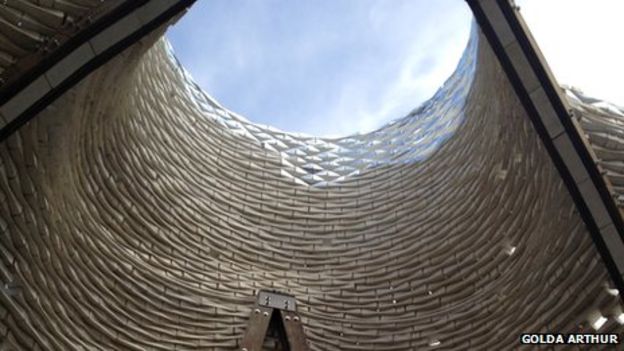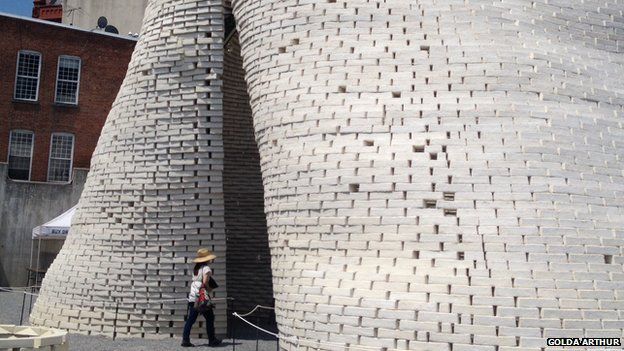Much of the construction industry depends on fossil fuels, creating a big carbon footprint. As pressure mounts to make construction "greener", experts have started to design houses out of hemp and straw, and bricks made of mushrooms.
From a distance, it looks like something out of a desert landscape, ancient and handmade.
The closer you get, the more you see something much more modern in the curves of this tower, assembled from 10,000 bricks.
But it is only when you examine one of those bricks close-up that you get a sense of what the future might hold. Using bioengineering, this structure has been made from mushrooms.
"This is a hybrid of what I call an ancient technology of mushrooms and a totally new technology of computation and engineering," says architect David Benjamin.
The mushroom - or mycelium, the vegetative part of the fungus - is an ideal material, Mr Benjamin explains.
These bricks score high marks for sustainability because they were "grown" with no carbon emissions and no waste.
The 40ft (12m) structure he is referring to currently sits in a courtyard at MoMA PS1, an art gallery in New York.
The mushroom brick is "grown" by mixing together chopped-up corn husks with mycelium.
The mixture is then put into a brick mould and left to grow for five days. The result is a brick that is solid, but lightweight.
The "mushroom tower" is then assembled using a custom algorithm to lay the bricks layer by layer.
This method lets builders use local materials like agricultural waste, and also makes the bricks biodegradable.
These particular bricks were created from materials in the New York area. But the method can travel. In places where rice is abundant, people can use rice hulls in the mixture with mycelium to create bricks.
How the mushroom house was built
 GOLDA ARTHUR
GOLDA ARTHUR- Old cornstalks and parts of mushrooms were collected
- The organic material was put into a mould and then allowed to set as bricks
- The bricks were arranged to create the structure
- Some of the blocks at the top of the building were covered in light-refracting film
Source: Museum of Modern Art
Mr Benjamin's belief in the power of biotechnology is evident in the name of his architectural firm, The Living.
"We want to use living systems as factories to grow new materials," he says. "Hopefully this will help us see cities more as living breathing organisms than solid, static, inert places."
Meanwhile another architect has also been growing "bio-bricks", using a different process.
Ginger Krieg Dosier is the creator of a brick made with sand and bacteria, filled into a mould and then fed with a nutrient solution. Five days later, the bricks are removed and ready to use.
The chemical reaction caused by this mixture "bio-cements" the grains together to create a solid brick.
This quest for the bio-brick took Ms Dosier from the world of architecture to science, where she consulted with microbiologists and chemists in order to come up with a formula.
 GOLDA ARTHUR
GOLDA ARTHUR
"Even as a child, I have been fascinated with how nature is able to produce durable and structural cements in ambient temperatures," she says.
Her brick is now being used in a pilot project to make paving.
She worked for a while in the United Arab Emirates - where sand, of course, is plentiful - but has now relocated her company, BioMason, to North Carolina.
The work of Mr Benjamin and Ms Dosier point to a new level of innovation which some say is much needed in the building industry.
"While they are experimental, it is very exciting to see these types of leapfrog technologies that take cues from nature to find creative alternatives to some of the oldest conventions in design," says Jacob Kriss from the US Green Building Council.
The council is responsible for a rating system called LEED, which rewards sustainable design in buildings. Mr Kriss says the building sector is responsible for almost 40% of carbon dioxide emissions in the US.
"There is an unquestionable imperative to green our stock of both new and existing buildings," Mr Kriss says.
"It is these types of innovations that can help us turn the corner to create resilient, healthy, high-performing structures that are better for the planet and the people who use them every day."
now for a how to if you're interested in the process of growing your own bricks.







